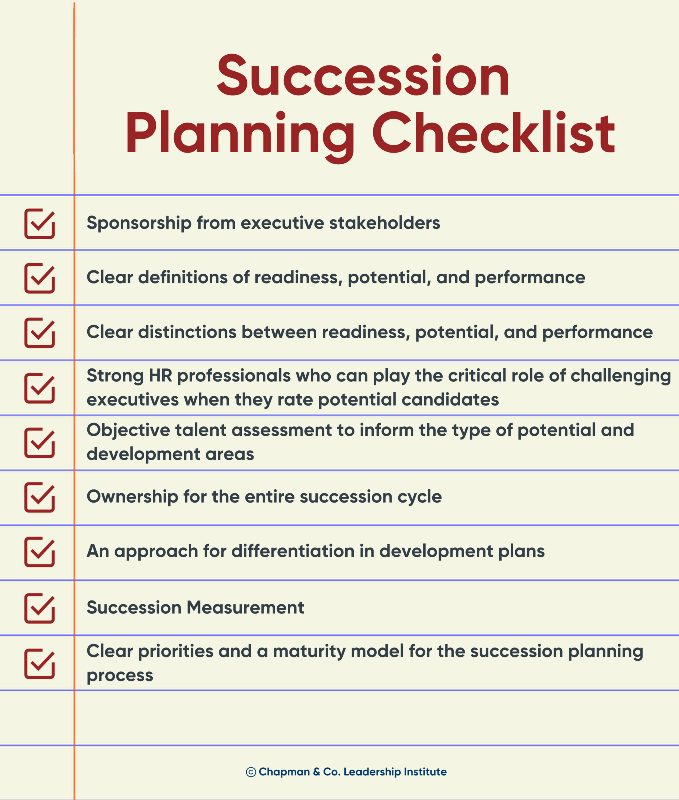Succession Planning Template: How to Ensure Your Team is Ready

Related Insights
Succession Planning ensures you have a plan in place to identify, develop, and equip your organization’s future leaders so they are ready to meet the business demands of tomorrow. Often the process looks like this: HR facilitates a conversation with the leadership team leveraging a 9-box with performance and potential along the axes. Leadership rates their internal talent, and names potential successors to then receive employee development such as leadership development, executive coaching, or mentoring. Easy to explain; hard to implement. Smart organizations know that the right talent will not suddenly become ready; it takes intentionality. To wit, 79% of companies in the top 25% of their industry have formal succession plans. However, the difference in their success likely relies more on the fact that those same companies take the steps necessary to implement their action plans, with more than three-fourths filling their executive leadership positions internally (Strategy-business, 2015). So, before you begin the work of succession planning, consider the following succession plan template components to ensure your plans yield the reality you seek.
1. Sponsorship from executive stakeholders
Successful succession starts at the top. Without executive-level sponsorship and buy-in from the Board, succession efforts, especially for leadership changes will likely falter - looking good on paper but lacking in practical application. Executive buy-in is essential for ensuring a smooth transition for leadership roles and other key positions.
2. Clear definitions of readiness, potential, and performance
When there is confusion about how the critical components of succession are defined, leaders will struggle to objectively and consistently rate readiness, potential, and performance across their talent pool. By working to simplify and define these categories, organizations can streamline their succession management processes and excel in identifying talent development opportunities to match.
3. Clear distinctions between readiness, potential, and performance
Clarity in the minds of HR – and then leaders – is a critical step to a process that makes sense from beginning to end, gathering data that is value-add for talent decisions on key positions.
4. Strong HR professionals who can play the critical role of challenging executives when they rate potential candidates
Good leaders invest in their team members, but their minds can become locked into one way of viewing their talent. HR needs to have the credibility, facilitation skills, succession expertise, and hard-won experience to drive effective conversations that yield accurate results and strengthen executive buy-in.
5. Objective talent assessment to inform the type of potential and development areas
Even the most insightful leader can’t see what is “under the hood” of a potential successor. Formal talent assessments not only add objectivity to what can otherwise be a subjective exercise – critical for decreasing bias and increasing the diversity of your leadership pipeline – but, they ensure more predictable employee performance.
6. Ownership for the entire succession cycle
Effective succession planning takes a village. But someone still needs to have ultimate accountability for the process. Without clear ownership, a simple succession plan can become more complex than it needs to be. It can also result in ambiguity for both key roles at play - the process implementors the leaders and the successors who experience it.
7. An approach for differentiation in development plans
“We’ve got names in boxes…now what?” The last thing executives want to hear is that their hard work deciding whether someone fell in the 8 or the 9 box is that they are going to participate in the same development opportunities anyway. Make sure there is a clear “so what” following the placement of talent in their respective boxes – that you are using those distinctions to strategically invest your resources so that each category of talent has a roadmap to meeting their development needs and is aligned for your organization’s long-term success.
8. Succession Measurement
Often, HR gets a bad rap for lacking data-driven decisions focused on the ROI. Don’t let that happen with your succession planning process and ensure you are set up to receive metrics on the return of your investment.
9. Clear priorities and a maturity model for the succession planning process
Know why your organization needs a business succession plan, not just because it sounds like a good idea in general (which it is), but because there is a clear rationale specific to your organization. For example, perhaps your organization knows you have upcoming disruptions within the industry and the leadership competencies required for success will need to shift to deliver on the business strategy. Assessing talent against the upcoming demands, identifying critical roles and key competency skill gaps, and then preparing leaders to meet those business challenges is much more compelling than simply saying succession is a best practice.
Designing an effective succession planning process can be challenging – even for those with a wealth of experience in leadership and HR. Chapman & Co. partners with organizations to deliver on their business priorities leveraging their most valuable asset – their people. Contact us to explore how we can help your organization become future-proof.

Download a Succession Planning Template quick reference guide







